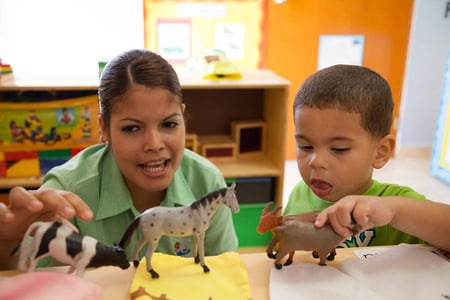
The scenario: A teacher is sitting with several children having snack, and the teacher asks a student, “What are you going to be for Halloween?”
Is this question open-ended or closed-ended?What is the definition of an open-ended question? We talk about them a lot in reference to the CLASS tool, but do we define them? In a recent debate over the scenario above, I considered the question open-ended, while my colleague did not.
We discussed some of the reasons it may not be open-ended. For one thing, the question the teacher asked started with the word, “What.” Secondly, the child could answer with one word, such as “Ninja Turtle.” Finally, the teacher may already know the answer. But, I'd argue that there's more to think about when it comes to defining open-ended questions.
What is the "What?"
Let’s start with the word “what.” There are times when “what-questions" are very closed-ended. They include questions such as, “What color is your shirt?”, “What shape is this?”, “What is this?” (pointing to a picture), or “What letter makes the /huh/ sound?” These really are closed-ended questions with answers limited to one-word responses (red, diamond, a cat, H).
However, the questions “What do you think this book will be about?”, “What happened?”, “What do you think?”, or even “What did you have for breakfast?” prompt children to “...put together words to communicate more language overall or potentially more complex ideas” (Toddler CLASS Manual, pg. 60).
What does the CLASS Manual say about open-ended questions?
The Toddler CLASS Manual defines open-ended questions as, “...opportunities to respond to the teacher using more than one word, or any type of complex language (e.g., using descriptor words or prepositions)...teachers may pose questions for which the answer is unknown [but] questions may also have a known answer” (pg. 60).
The pre-K and K-3 manuals state, “Open-ended questions are those that invite elaborate responses...Often, these are questions for which the answer is unknown [however] questions may have a known answer” (pg. 79). Note here that teachers may already know the answer to the question posed.
It is also important to note that open-ended questions may not be a question at all. They might just be a statement. An open-ended statement may sound like, “Tell your friends about your visit to the dentist, Hunter!”, “Tell me about your picture...”, or even “Share your story with the group, Tanieshia.” Notice how these statements initiated by the teacher invite children to respond elaborately.
What do these questions (or lack thereof) look like in classrooms?
It is also helpful to think about what a classroom would look like in the low-range for open-ended questions. When classrooms measure in the low-range, observers should note that students rarely, if ever, have opportunities to respond to the teacher with more complex language.
As observers, I think it is helpful to note the phrase “invites elaborate responses” by the indicator “Open-ended questions.” This will prompt you to think beyond the word “requires” in your behavior markers.
So, “What are you going to be for Halloween?”
Many participants in CLASS Observation Trainings ask if it's okay to judge whether a question is open-ended or not by the children's answers. I say yes and no.
Remember that teachers asking open-ended questions/statements is only the first piece. They must also give students time to respond to the questions. If our teacher in the scenario asked a lot of questions, including open-ended questions, but never gave children a chance to respond, then usually I would score that in the mid-range.
While I must ask myself if the teacher gave the student a chance to respond, the student may say “...a scary black cat with a big tail!” The student may also go on to excitedly share what his sibling was going to be for Halloween as well.
Whether you are an observer, a coach, a trainer, or even a teacher, I hope this post stretches your definition of “open-ended” questions and statements!

